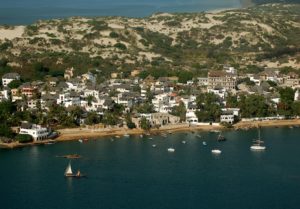Cyclone Idai highlights vulnerabilities, need for investment in resilience
Three weeks after Cyclone Idai laid waste to areas of Mozambique, Malawi and Zimbabwe, the full extent of the damage is still unknown. The cyclone made landfall on March 14, bringing torrential rain, 120mph winds, severe flooding and landslides that took hundreds of lives. It destroyed roads, crops and other vital infrastructure, affecting millions. Beira, Mozambique, was hit the hardest, losing 90% of its buildings and public infrastructure. Immediate aid is needed for nearly 3 million people, and the UN and partners are asking for $394 million to fund their humanitarian efforts – only a small fraction of which has been funded so far.

Africa is already plagued by the effects of climate change, and Idai is yet another stark reminder of the continent’s vulnerabilities. After the storm passed, people were stranded in trees and on rooftops for days without access to basic services; damaged roads prevented aid from reaching some villages; families were separated as they fled, and children and the elderly were left behind. Now, there are hundreds of thousands of people sheltered in cramped schools, IDP camps and other emergency refuges, as well as many who have been forced to leave their home countries altogether. With large swathes of crops destroyed, many are largely reliant on aid, and with water and sanitation systems non-functional, cases of cholera are on the rise.
As plans for recovery are made, an opportunity arises to incorporate resilience into the affected communities as they are rebuilt, improving their preparedness so that the next time they experience a shock such as Idai, the initial damage will be less and they will be able to bounce back more quickly. This sentiment has been echoed by many, including Mami Mizutori, the UN Special Representative for Disaster Risk Reduction, who said in response to the cyclone that, “no matter how effective early warnings are, there is still a huge demand for greater investment in resilient infrastructure…if we are to break the cycle of disaster-response-recovery.”
While community-based flood-risk strategies are starting to look at how to mitigate and better prepare for floods, many challenges, such as lack of funding, limited community participation, and gaps in planning, implementation and maintenance of preparedness systems remain, according to the IFPRI.
In Africa, there is funding available to invest in more resilient infrastructure and renewable energy, but it is instead being poured into the fossil fuel industry, argues Landry Ninteretse – the Africa lead for 350.org. Thus, the onus falls on national governments and international organizations to divert funding from destructive industries and direct it instead to sustainable, resilient ones. For Africa, the continent that produces less than 4% of global carbon emissions, “climate change is not a future risk, it’s already a reality evident in wrecked families, lands and livelihoods, and hopeless children and young people who have no choice but to seek a future by migrating”, writes Ninteretse. Cyclone Idai is a clear demonstration of this, and of “the exposure and vulnerability of many low-lying cities and towns to sea-level rise as the impact of climate change continues to influence and disrupt normal weather patterns”, added Mizutori. This calls for “more and urgent investment in ecosystem-based disaster risk reduction and climate change adaptation”, with a more systematic and comprehensive approach, according to UN Environment’s Regional Director for Africa, Juliette Biao.

One early attempt to do this is the Coalition for Disaster Resilient Infrastructure (CDRI), launched by representatives from 33 countries and various international bodies in the wake of Cyclone Idai at the 2nd International Workshop on Disaster Resilient Infrastructure (IWDRI) in New Delhi on March 20. While still in very early stages, the Coalition aims to develop best practices, a global risk and resilience review and standards for appropriate governance arrangements around investing in and developing resilient infrastructure.
“When we lose hospitals, schools, roads, railways, airports, electricity supply and telecommunications in disasters the result is a major setback for eradicating poverty and achieving sustainable development”, said Kamal Kishore of India’s National Disaster Management Authority – co-hosts of the IWDRI. As losses of life, livelihoods and infrastructure from climate-related shocks escalate worldwide, investment in resilience building must become a priority and a reality if the impact from disasters like Idai is to be minimized.
Sources and Further Reading
Climate-driven migration in Africa – European Council on Foreign Relations
How Cyclone Idai floods are impacting food security in Malawi – IFPRI
Cyclone Idai: Why disaster awareness and preparedness matters – PreventionWeb
Cyclone Idai Lays Bare the Fundamental Injustice of Climate Change – Resilience
Cyclone Idai shows the deadly reality of climate change in Africa – The Guardian
Coalition for Resilient Infrastructure takes off – UNISDR
Cyclone Idai highlights urgent need to ensure resilience of infrastructure to extreme weather – UNISDR
Cyclone Idai – UN OCHA
Mozambique: 11 cholera treatment centres established as number of cases continues to rise – UN OCHA
